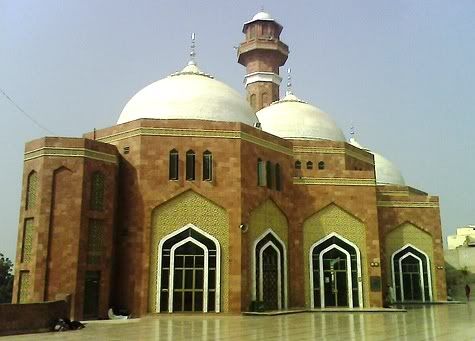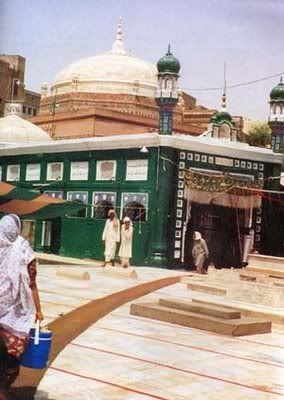Pakpattan – the name is enough to start the travelers, cautiously curious and devoted faithful dreaming. Already the magic words like sultans and saints are stirring in the head. Let your gaze slip over the dhaki – original citadel of Pakpattan – and the town will suddenly appear. The antiquity is its own message: the town is heritage, and heritage permeates the town.

Enter the once walled inner-city through one of the existing gates and you will find yourself in archetypal form of an ancient town – crooked and narrow streets, dense housing, intricate woodwork on Jharokas, bay windows and doors. So many historic cities have developed losing much of their original character in the process during modern times, but Pakpattan has survived remarkably in tact.
It is the entire urban fabric of the place that is historic. Though, the major portion of the fortification wall has disappeared. At places, the wall has even been utilized as a part of the residences. Four gates (Shahedi, Rehimun, Abu and Mori) have survived out of six but they are all crumbling. Now extensive suburbs stretch from the foot of the wall all around. Thin red bricks from centuries old wall are seen used in the new houses all over the town. The portion of the settlement that sits on the mound can be compared with walled part of Multan City.
The remains of peripheral wall with ancient mystique define the inner portion that is totally pedestrian, vehicular traffic and modern development contained out of the wall. Homes have also retained their essential trait despite renovations to make them comfortable for modern living or to create additional space for more families. You can see the mythical woodwork, murals as well as tiled facades and colorful patterns in old havelies.
General Alexander Cunningham has recognized Pakpattan, anciently known as Ajudhan, as a town that appears in the work of Hellenic historians and other classic writers under the names of Ohydrakae, Sydrakae, Sudraykae and or Hydaekae. Two strategic roads of the past – one from Dera Ghazi Khan and other from Dera Ismail Khan – used to meet here. Great conquerors like Mahmud Ghaznavi, Taimur and traveler like Ibn-e-Batuta crossed Sutlaj from Pakpattan that had been principal ferry on River Sutlaj for centuries.
Medieval history of the town started when Amir Subuktagin subdued Pakpattan in 980 (AD) followed by Ibrahim Ghaznavi in 1080. Even today, the thought that Taimur during his invasion in 1398 spared the lives of those who had not fled the place, out of respect for the shrine of saint Baba Farid, inspire reverence.
 The soul of the city is famous saint Farid-ud-Din Masud Ganj Shakar commonly known as Baba Farid. The saint was born in a village Kothewal (near Multan) in 1173 in a family that had migrated from Afghanistan. Saint, scholar and poet, Baba Farid traveled to Khurasan, Kirman, Badakhshan, Baghdad, Mecca Muazzma, Madina Munawara, Kufa, Basra, Damascus, Nishapur, Bukhara, Dehli and Multan before he finally settled in Pakpattan. Here he spent his life in spreading the light of divine Islam.
The soul of the city is famous saint Farid-ud-Din Masud Ganj Shakar commonly known as Baba Farid. The saint was born in a village Kothewal (near Multan) in 1173 in a family that had migrated from Afghanistan. Saint, scholar and poet, Baba Farid traveled to Khurasan, Kirman, Badakhshan, Baghdad, Mecca Muazzma, Madina Munawara, Kufa, Basra, Damascus, Nishapur, Bukhara, Dehli and Multan before he finally settled in Pakpattan. Here he spent his life in spreading the light of divine Islam.
It was due to the religious services and personal example of the saint that Islam spread in this part of the Subcontinent and many people including Hindu Jogi Birnath along with his followers came into the folds of Islam. The saint died in 1265 and his shrine was constructed by Khwaja Nizam ud Din Auleya in 1267.
Splendors of the ‘Farid Complex’ fire the imagination. The shrine – simple and destitute of ornament – stands next to the bigger shrine of his grandson Ala ud Din Mouj Darya, which was built by Sultan Muhammad Tughlaq. The main chamber of the shrine of Baba Farid has two doors – one in the East is called Noori Darwaza and the other in South in famous Baheshti Darwaza. Besides the principal grave of the saint, there is another grave in the chamber where his son Badr ud Din Suleman is buried. The ample, pure and unadorned architecture is very inspiring. Urs of the saint is celebrated in the month of Muharram but large of devotes stream into the shrine everyday. You can also see Qawwal groups performing and malangs falling in state of trance mostly on Thursdays.
Both the principal shrines are in good condition but the adjoining ancient mosque has decayed. Auqaf is constructing a new mosque nearby as a part of Farid Complex. Besides the shrines of Baba Farid and Mouj Darya, there are over twenty shrines of saintly persons in the town. Most eminent out of these is the shrine of Baba Aziz Makki.
There is a whole different world outside the shrine parameters. Cubbyhole shops selling deathbed spreads, flowers, big bangles and sweets (for niaz) known as Makhane and eating joints are lined up in both the streets leading to the shrine. Business in the streets is thriving because devotees ‘must’ take something home from the shrine. Sleazy sounding and persistent beggars flock around devotees heading for the shrine. People are seen distributing free food: cooked food is available for sale in large quantity round the clock. A philanthropist from Karachi is running a separate Lunger Khana at his own expense since 1995. Bustling with activity, the place seems to have its own culture.
How the name Ajudhan was changed to Pakpattan? It is a fact that name Pakpattan (meaning pure ferry) distinguished due to the home and last resting-place of Baba Farid. According to a local lore, Mughal King Akbar on the eve of his visit to the shrine to pay homage to the saint declared Pakpattan as an official name of the town. The thought that so many people including Ibn-e-Batuta, Guru Nanik Dev Jee and Waris Shah had visited the shrine evokes awe and aura of eternity.
Wandering about in the older part of town near the relics of Kacha Burj – defensive tower that was erected by Haibat Khan during the rule of Sher Shah Suri, you can think about the strategic importance of this town in the bygone era. But, during Mughal time when danger from the North reduced, the town lost its defensive significance.
Pakpattan was first declared district headquarters in 1849 when British rule established in the Subcontinent. The headquarters were later moved to Gugera in 1852 and then to Sahiwal in 1856. British also instituted Pakpattan Municipal Committee in 1868. Kasur-Lodhran section of Railway line was laid in 1910 and Pakpattan became an important station on the Railway map because of railway divisional headquarters and loco sheds. Though this section of railway line was torn apart and sent to Mesopotamia during Second World War and the town could not prosper as an agricultural market in those days. On July 1, 1990, Pakpattan was again declared district headquarters. This became the only district of the country without any tehsil until Arifwala tehsil was included in the district in 1995.
In order to preserve the bits and pieces of history lying under the layers of time, the experts could carry out a survey to record the places having essential significance. The living heritage should be declared as ‘protected area’ – A concept that presently is not there in Pakistan.
This post first appeared in S.A.J. Shirazi’s blog Light Within.



















































You could certainly see your skills within the work you
write. The world hopes for even more passionate writers like
you who aren’t afraid to say how they believe. Always follow
your heart.
http://www.talkchatroom.com